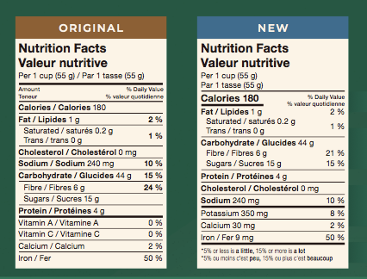The Real Deal on Sugars and the Nutrition Label
Submitted by Angela on May 17, 2021 - 2:08pm


THE SWEET SPOT CHALLENGE!
Did you know that Health Canada is making changes to our nutrition labels? All food and beverage products will display the new labels by December 2021, but you may see some products with the new labels sooner! In the picture below is a comparison of the old and new labels… Do you notice anything different?
Health Canada has put calories in a larger font for ease of reading, and added a footnote at the bottom to explain the % Daily Values and what those numbers really mean. The really big changes however are related to sugar.
The labels will now include TOTAL sugar which is both natural containing and added sugars. You may also notice that a new % Daily Value has been added for sugar! But why? The point of adding this percentage is to help Canadians compare sugar content in various food products more easily, and get an idea of how much this contributes to a total daily intake (The Canadian Sugar Institute, 2021). Research shows that those who consume moderate amounts of sugar have higher intakes of fibre, calcium, vitamin D, vitamin A, vitamin C, and potassium (The Canadian Sugar Institute, 2021). This is one reason behind Health Canada’s recommendation that we get most of our sugars from food sources from fruits, vegetables, and dairy products – we get an extra punch of nutrients along with it (The Canadian Sugar Institute, 2021)!
In the above example, the daily value for sugar is 15%, meaning there is a lot of sugar in that portion of that product, out of a total daily caloric intake from 2000kcal, this new % Daily Value is based off 100 grams of sugar in a total daily intake of 2000kcal. Health Canada states that “this value is not a recommended level of intake”, it is simply an average amount of sugar that coincides with a healthy eating pattern (The Canadian Sugar Institute, 2021). However, this can get confusing if you don’t take into account that these labels are based off of a 2000 daily calorie diet. So for individuals who may require MORE than 2000 calories in a day, how does this new DV for sugar relate? The % Daily Value of 100g sugar is essentially calculated as 20% of your total daily intake (The Canadian Sugar Institute, 2021). For example, a 3000 calorie diet would equal 150g sugar, 3500 calories = 175g sugar, etc. This is why 100g of sugar is not a recommendation as everyone’s nutritional needs are so different!
The other big change with sugar to food labels is in the ingredient list. There are so many different names for sugar: glucose, fructose, dextrose, corn syrup, the list really does go on. Because of this, it can be hard to identify how many sources of sugar are actually in a food. With the new ingredient lists, all types of sugars will be grouped together in parentheses! Since Health Canada requires companies to list the ingredients of a product by weight in that product (from highest to lowest), all sugars will be placed in the list based on their combined total weight.
SO HERE’S THE SWEET SPOT CHALLENGE! Now that we understand the changes coming up to the new food labels, and that 100g of sugar can be consistent with a healthy eating pattern (for those requiring 2000 calories/day), what does 100g of sugar in the run of a day even look like? Here is an example of daily menu from The Canadian Sugar Institute that shows a whole day of foods which totals 100g of sugar
What does this mean for athletes? Well, carbohydrates are our main source of fuel and can be found in the form of starches, sugar, or fibre. Carbohydrates are also the most efficient fuel source for the body! As you increase your physical activity, the more carbohydrates you need for optimal health and performance before, after, and even sometimes during exercise. Carbohydrate intake should vary day-to-day based on an athlete’s volume and intensity of training (Scaramella et al., 2018). This table shows the recommendations of how many carbohydrates athletes should consume during a day based on their bodyweight.
Carbohydrates during exercise may be necessary because adequate glycogen stores can sustain moderate to intense exercise for ~90-120 minutes (longer than this means an athlete needs to load back up!). Below is a table that shows how many carbohydrates an athlete may need during and after exercise. Be sure to pair your post-exercise carbohydrates with a good quality protein source to repair your muscles through muscle protein synthesis!
Now back to sugar! Athletes typically need more than the 2000 calories a nutrition label is based off of, therefore they will need more than 100g of total sugars in the run of a day. As mentioned before, a 3000 calorie diet = 150g of sugar. But what does 150g of sugar look like in a day? As you can see it is easy to add up sugars to meet your totals, by including a WIDE VARIETY of foods through regular meals and snacks through the day! Check out www.sugar.ca for more great resources and recipes and find how to sugars can be a part of a healthy diet!
Note: During training snack is for one hour or more of exercise. If training for two hours, this need would be doubled.
Featured Below: Instant Bircher Muesli!
For more information regarding the new labels and/or ingredient lists, and all things sugar, visit The Canadian Sugar Institute at https://sugar.ca
Burke, L. (2015). Clinical sports nutrition (5th ed.). McGraw-Hill Education.


